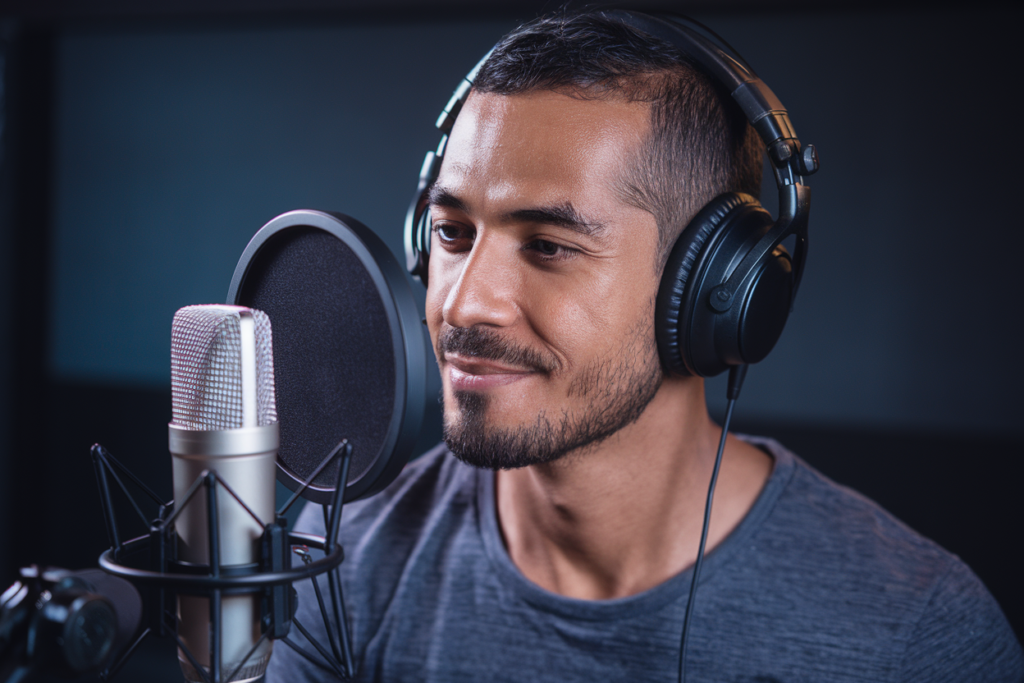Key Takeaways
- Importance of Authenticity: High-quality Arabic voiceovers require an understanding of the nuances in dialects and accents, which enhances relatability with specific audiences.
- Quality Equipment Matters: Investing in quality microphones and audio interfaces significantly improves clarity and professionalism in recordings.
- Optimize Your Recording Environment: Acoustic treatment reduces unwanted noise and echoes, leading to clearer sound quality without needing a professional studio setup.
- Preparation is Key: Familiarize yourself with your script and practice reading techniques to deliver engaging performances that resonate emotionally with listeners.
- Voice Warm-Up Exercises: Incorporate warm-up exercises to improve vocal clarity, control, and range before recording sessions for better performance outcomes.
- Effective Post-Production Techniques: Editing, mixing, and enhancing audio during post-production are crucial steps for creating polished Arabic voiceovers that captivate audiences.
Ever wondered how to capture that perfect Arabic voiceover? With the growing demand for authentic content in Arabic, knowing how to record high-quality voiceovers can set you apart. It’s not just about having a good voice; it’s about technique, equipment, and understanding your audience.
Whether you’re a seasoned professional or just starting out, mastering the art of recording can elevate your projects and engage listeners like never before. You’ll learn tips on choosing the right microphone, optimizing your recording environment, and even some tricks for delivering that captivating performance. Ready to dive in and discover how to make your Arabic voiceovers shine?
Understanding Arabic Voiceovers
Arabic voiceovers play a crucial role in conveying messages authentically and effectively. Grasping the nuances of this art form allows you to create compelling content that resonates with your audience.
Importance of Quality in Voiceovers
Quality matters significantly in voiceover work. High-quality recordings enhance clarity, ensuring listeners easily understand the message. Poor audio can distract or confuse your audience, diminishing engagement. Investing in professional equipment and soundproofing creates a polished product that reflects well on your brand. Your choice of voice talent also influences quality; experienced voice artists know how to deliver scripts with emotion and precision, elevating your project.
Differences in Dialects and Accents
Arabic features numerous dialects and accents, each carrying its cultural significance. Understanding these differences is essential for selecting the right voice actor for your project. For example, Modern Standard Arabic (MSA) serves as a formal version understood across the Arab world, while regional dialects vary widely—from Egyptian to Levantine or Gulf Arabic—each offering distinct sounds and expressions. Tailoring your content to reflect the appropriate dialect ensures relatability and authenticity, helping you connect more deeply with specific audiences.
Equipment Needed for Recording
To achieve high-quality Arabic voiceovers, investing in the right equipment is essential. The tools you choose can significantly impact the clarity and professionalism of your recordings.
Microphones and Audio Interfaces
Selecting the right microphone plays a vital role in capturing clear audio. Condenser microphones are often preferred for voiceover work due to their sensitivity and frequency response, making them ideal for vocal performances. Consider models from trusted brands that offer durability and quality sound.
Audio interfaces also matter. They convert analog signals from your microphone into digital data for your computer. Look for an interface with high-resolution capabilities; this ensures your recordings maintain fidelity. Also, ensure it has phantom power if you opt for a condenser mic which requires additional power to operate effectively.
Acoustic Treatment for Your Space
Acoustic treatment transforms any room into a suitable recording environment. Soundproofing reduces unwanted noise, while acoustic panels help manage echoes and reverberations that can muddy your recordings.
You don’t need a professional studio; even simple solutions like foam panels or heavy curtains can make a big difference in sound quality. If possible, record in quieter areas during off-peak hours to minimize background noise disturbances.
Investing time and resources into selecting proper equipment not only enhances the overall quality of your voiceovers but also reflects professionalism, ensuring you connect better with audiences through engaging delivery.
Best Practices for Recording High-Quality Arabic Voiceovers
Recording high-quality Arabic voiceovers requires attention to detail and an understanding of the nuances involved. Implementing best practices can significantly enhance your final product.
Script Preparation and Reading Techniques
Preparing your script is crucial for a successful recording session. Ensure the text flows naturally, making adjustments as necessary to match your speaking style. Familiarize yourself with the content—read it multiple times to grasp its tone and emotion. This familiarity allows you to deliver an authentic performance, resonating with listeners more effectively.
When reading aloud, focus on articulation and pacing. Enunciate each word clearly while maintaining a steady rhythm. Practice varying your intonation; this keeps the delivery engaging rather than monotonous. Consider using pauses strategically after significant points or phrases—this adds emphasis and gives listeners time to absorb key messages.
Additionally, if you’re working with different dialects or accents in Arabic, practice adapting your voice accordingly. Understanding regional variations enhances relatability with specific audiences, allowing you to connect better through your voiceover work.
Voice Warm-Up Exercises
Voice warm-up exercises play an essential role in preparing for recording sessions. They help improve vocal clarity, control, and range while minimizing strain during long recordings.
Start with simple humming techniques—this gently engages your vocal cords without overexertion. Gradually transition into scales or lip trills; these exercises promote flexibility in your voice while warming up both higher and lower registers.
Incorporate tongue twisters into your routine as well; they’re fantastic for improving diction and agility when articulating complex Arabic phrases. For example, practice sayings like “أريد أن أذهب إلى السوق” (I want to go to the market) at increasing speeds without losing clarity.
Lastly, don’t overlook breath control exercises; they provide stability when delivering longer sentences or emotional lines. Inhale deeply through your diaphragm before speaking—this technique supports strong projection throughout your performance.
By implementing these practices consistently, you’ll notice a marked improvement in the quality of your Arabic voiceovers, resulting in engaging performances that resonate deeply with listeners.
Post-Production Techniques
Post-production is essential for achieving polished, high-quality Arabic voiceovers. This stage involves editing, mixing, and enhancing audio to create a final product that captivates your audience.
Editing and Mixing Audio
Editing involves removing unwanted sounds and improving clarity. Start by trimming silences or mistakes using audio editing software. Focus on normalizing volume levels to ensure consistent sound throughout the recording. Mix different tracks if needed; balance voiceovers with background music or effects so that each element complements rather than competes with the others.
Use equalization (EQ) to enhance vocal clarity. Adjust frequencies to highlight the voice while minimizing any distracting noises. Additionally, compression can help maintain consistent volume levels across various parts of your performance, ensuring that softer spoken words are just as audible as louder ones.
Adding Effects and Enhancements
Enhancements can elevate your Arabic voiceovers from good to great. Consider adding reverb for a sense of space and depth in your recordings—just be cautious not to overdo it. Too much reverb can muddy the clarity of speech.
Explore other effects like noise reduction tools to eliminate background hums or clicks that detract from the listening experience. For added professionalism, subtle pitch correction may refine slight inconsistencies in tone without altering the natural quality of your voice.
By mastering these post-production techniques, you position yourself as a top choice for clients seeking outstanding Arabic voiceovers that resonate deeply with their audiences.
Conclusion
Investing time and resources into high-quality Arabic voiceovers is essential for standing out in a competitive market. By mastering recording techniques and understanding your audience’s needs, you can enhance the authenticity of your projects.
Utilizing the right equipment and creating an optimal recording environment will greatly improve sound quality. Don’t underestimate the impact of post-production work; it’s where your recordings truly come to life.
Embrace these practices to elevate your voiceover skills. With dedication and attention to detail, you’ll create engaging performances that connect with listeners on a deeper level. Your commitment to excellence in Arabic voiceovers will set you apart as a trusted professional in the industry.
Frequently Asked Questions
What is the importance of high-quality Arabic voiceovers?
High-quality Arabic voiceovers are crucial for conveying messages authentically and engagingly. They enhance clarity, helping audiences connect with content effectively. Poor audio quality can distract from the message, making it vital to invest in professional equipment and experienced voice talent.
How do I choose the right microphone for recording Arabic voiceovers?
For recording high-quality Arabic voiceovers, condenser microphones are recommended due to their sensitivity and frequency response. Ensure the microphone is compatible with your setup, and consider using an audio interface that supports phantom power for optimal performance.
What techniques should I use when delivering a voiceover?
To deliver an effective voiceover, focus on articulation, pacing, and varying intonation. Familiarize yourself with the script to ensure natural flow, use pauses strategically for emphasis, and practice different dialects to enhance relatability with your audience.
Why is soundproofing important in recording environments?
Soundproofing minimizes background noise that can detract from audio quality during recordings. Using acoustic panels or heavy curtains improves sound isolation, creating a cleaner environment that enhances overall vocal clarity and professionalism in your recordings.
What post-production techniques improve my voiceover recordings?
Key post-production techniques include editing out unwanted sounds, normalizing volume levels, mixing tracks for balance, applying equalization (EQ) for clarity, and adding effects like reverb cautiously. These steps create a polished final product that resonates well with listeners.







